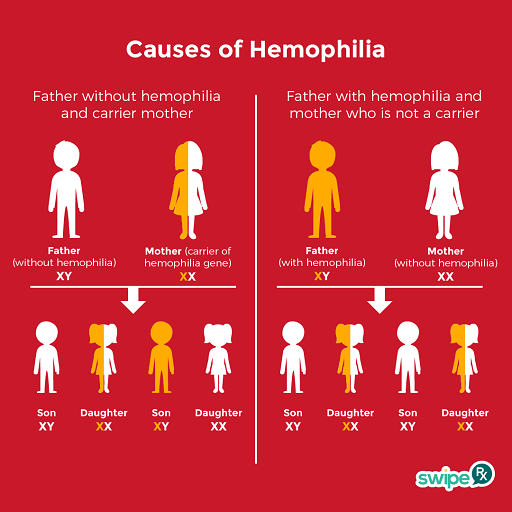Hemophilia is a blood disorder characterized by the lack of blood clotting proteins. In the absence of these proteins, bleeding goes on for a longer time than normal. Hemophilia almost always occurs in males and they get it from their mothers. Females are rarely affected with hemophilia.
Genetics of Hemophilia
Hemophilia disorder is inherited in an X-linked recessive pattern. This means that the gene causing hemophilia is located on X chromosome. Every male child inherits X chromosome from mother and Y chromosome from father. A female child inherits one X chromosome from mother and another X chromosome from father.
Thus a male child will get only one copy of the gene (because it’s located on X chromosome). Now, if gene gets mutated (and thus become cause of hemophilia), a male child will have only one mutated copy of this gene. This mutated copy will not be able to produce blood clotting proteins.

In case of female child, she will be a hemophiliac only if both the copies of the gene she gets, are mutated. This happens very rarely. Female child is more likely to get one mutated copy from mother and one normal copy from father. This normal copy of the gene will be able to produce about half of the normal blood clotting proteins — and that proves to be almost sufficient. But in rare cases, if both the copies of the gene she inherits are mutated — then her body will not be able to produce clotting factors and she will become hemophiliac.
Types of Hemophilia
- Hemophilia A: occurs due to low levels of clotting factor VIII
- Hemophilia B: occurs due to low levels of clotting factor IX. Also known as Christmas disease, after Stephen Christmas, the first patient described with hemophilia B
- Hemophilia C: occurs due to low levels of clotting factor XI
- Parahemophilia: occurs due to low levels of clotting factor V
Prevalence of Hemophilia
- Hemophilia A: affects 1 in 5,000–10,000 male children
- Hemophilia B: affects about 1 in 40,000 male children
- Hemophilia C: rare. Found equally both in males and females
Hemophilia as Disability
Just as with other blood disorders (like sickle cell disease), you may be able to claim disability benefits if your condition hampers you from working. In India, hemophilia has been listed as one of the 21 recognized disabilities under RPWD Act 2016.
Hemophilia Treatment
There is no known cure for hemophilia. The treatment for hemophilia involves injecting clotting factor into the patient — and this has to be done many times a week. Hemophilia treatment is expensive.
Use the citation below to add this article to your bibliography
"Hemophilia: Types, Definition, Genetics, Treatment, Disability." Wecapable.com. Web. May 28, 2025. <https://wecapable.com/hemophilia-types-definition-genetics-treatment-disability/>
Wecapable.com, "Hemophilia: Types, Definition, Genetics, Treatment, Disability." Accessed May 28, 2025. https://wecapable.com/hemophilia-types-definition-genetics-treatment-disability/
"Hemophilia: Types, Definition, Genetics, Treatment, Disability." (n.d.). Wecapable.com. Retrieved May 28, 2025 from https://wecapable.com/hemophilia-types-definition-genetics-treatment-disability/

sir,
I’ve been suffering from Polycythemia Vera, a blood disease/cancer for past 20 years.
The disese causes spleen enlargement, abnormal blood counts, fatigue, urticaria, bone or joint pains, etc. There is no cure except bone marropw transplant, though not very successful. Ive already written to the disabilities deptt. through the PG portal of India. Their response is hopeless. Though the list of disabilities covers 3 blood disorders, my disease is not covered. It is an accepted disability in other nations like the USA and UK. Why not in our nation ? How and where to proceed for this case?
Who should be in the medical board for the assessment of Hemophilia?